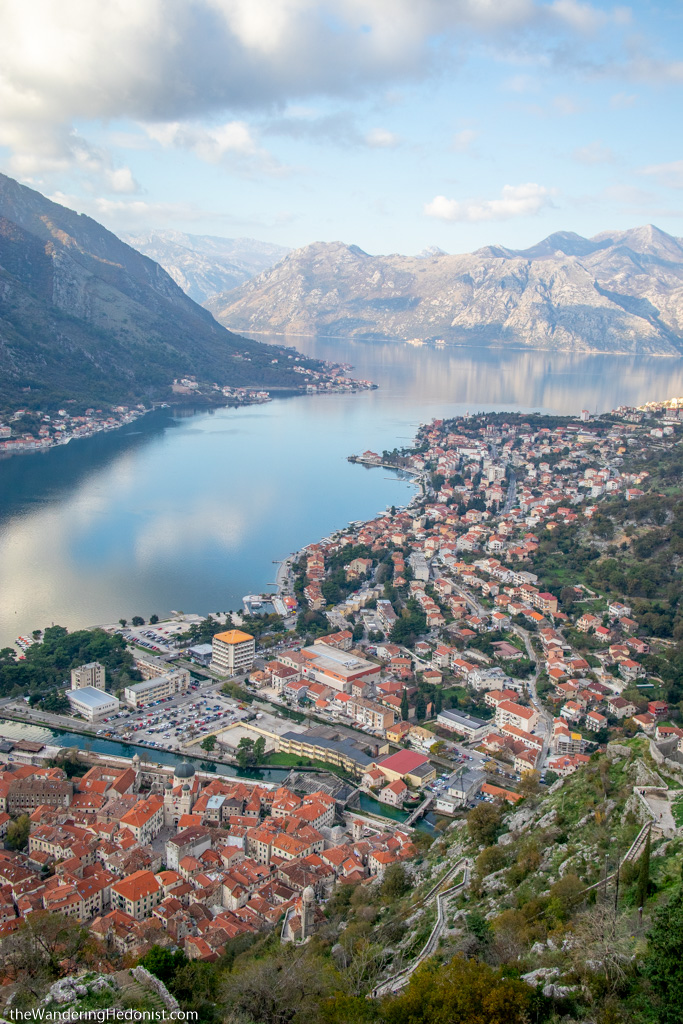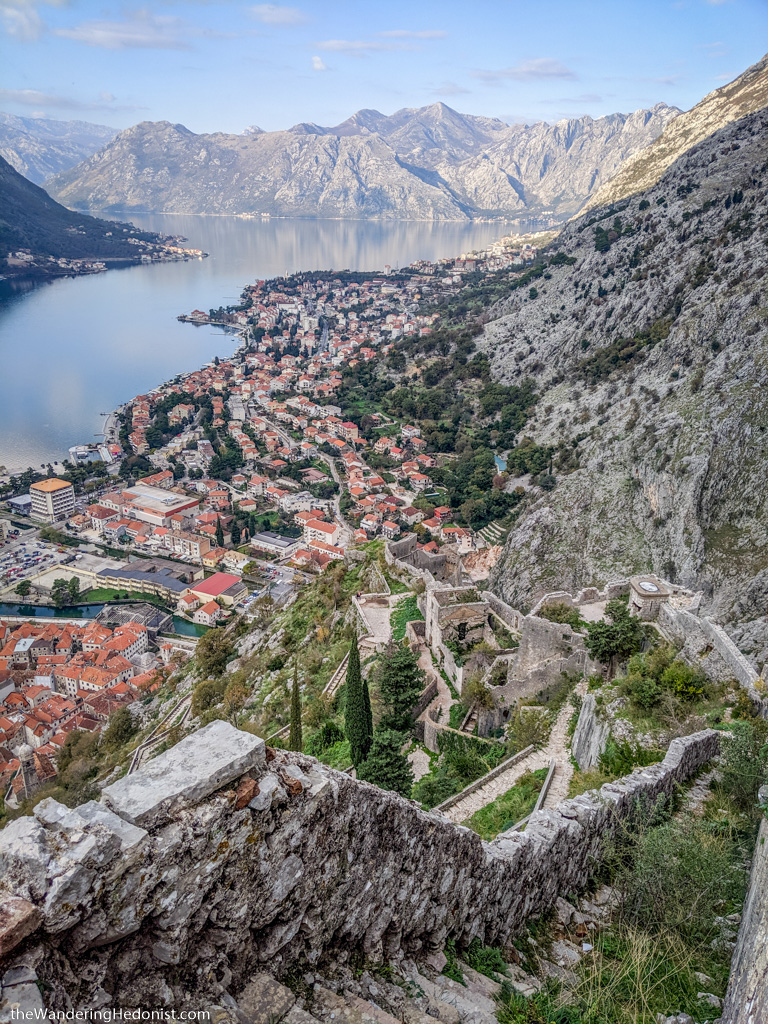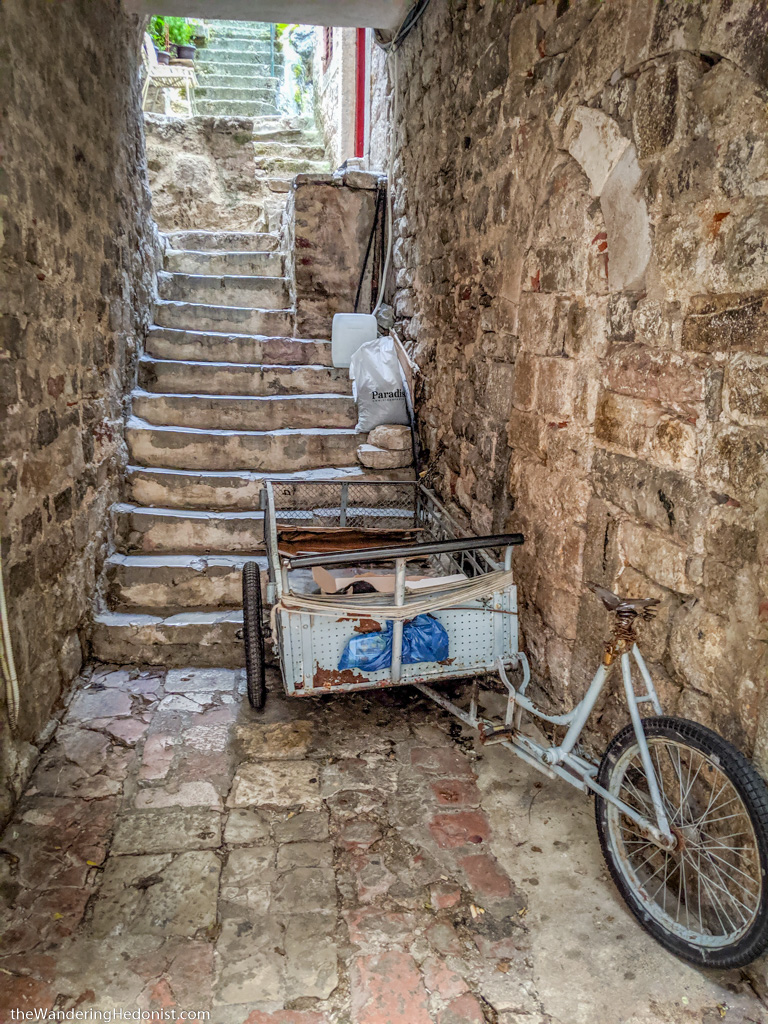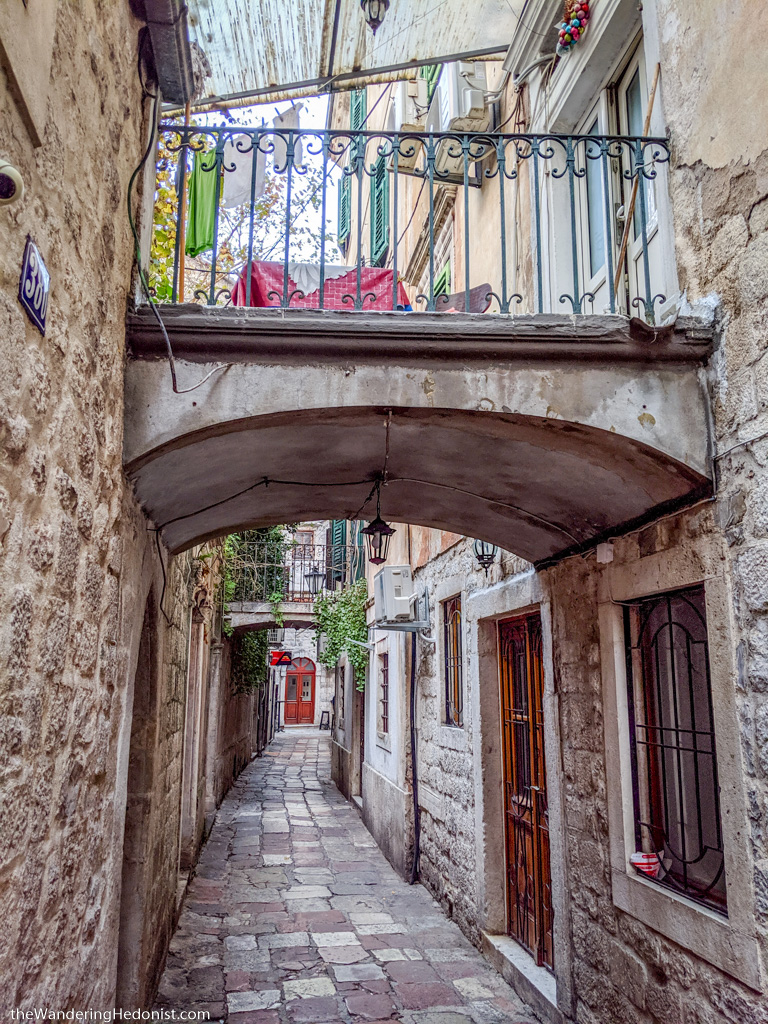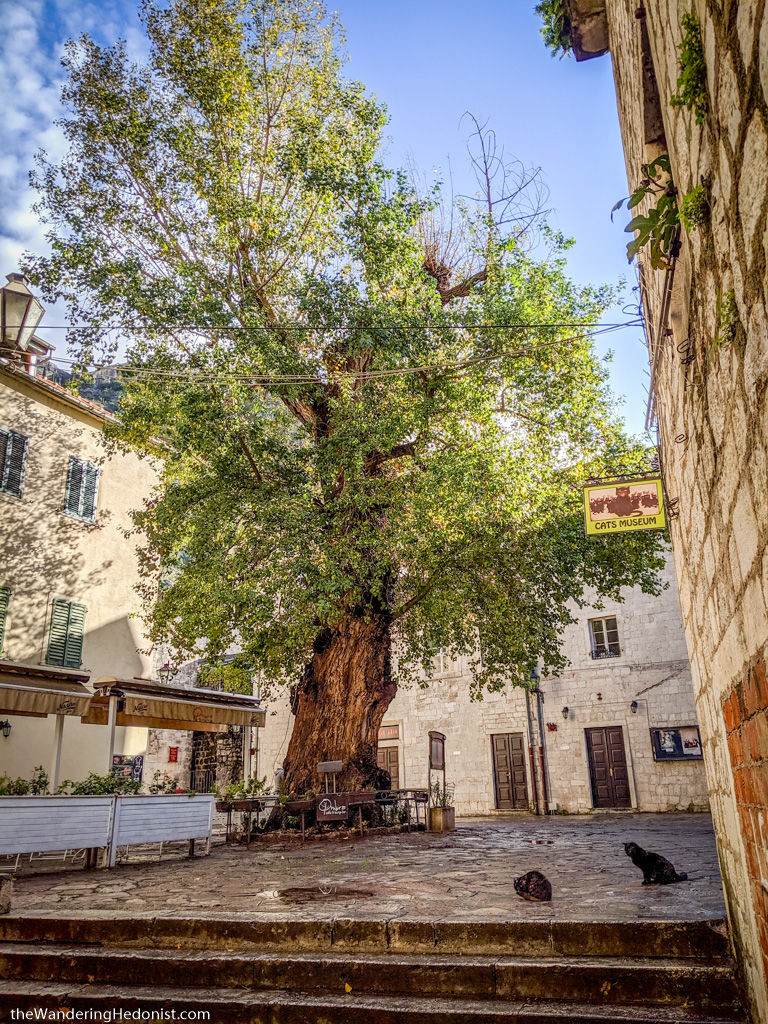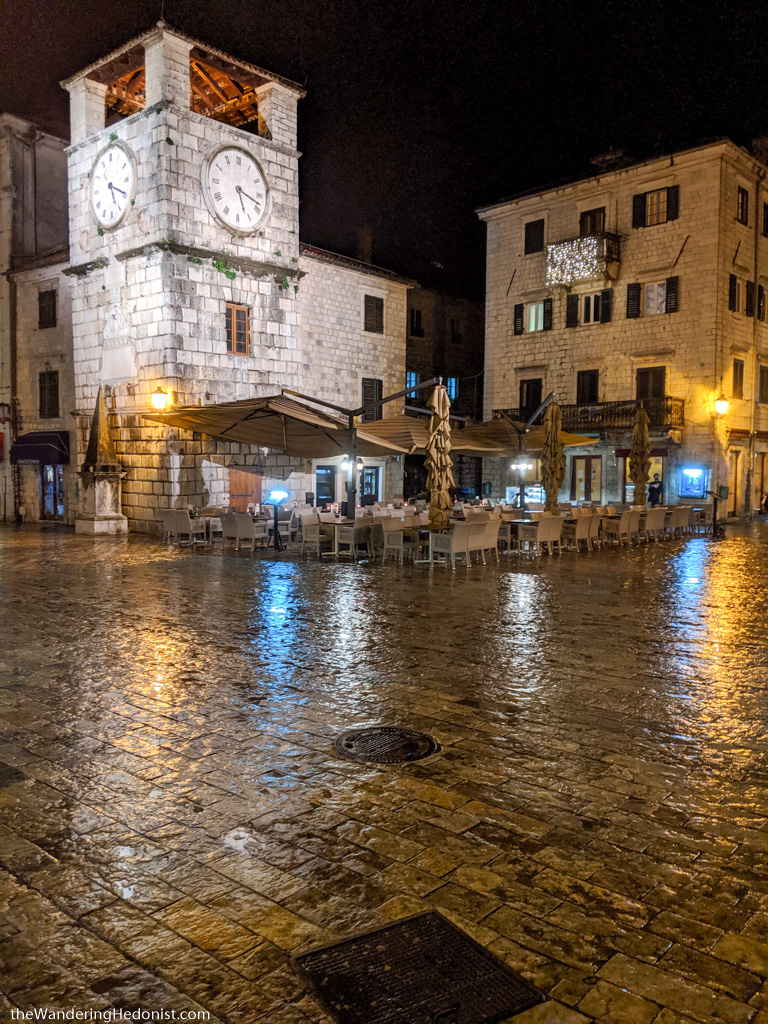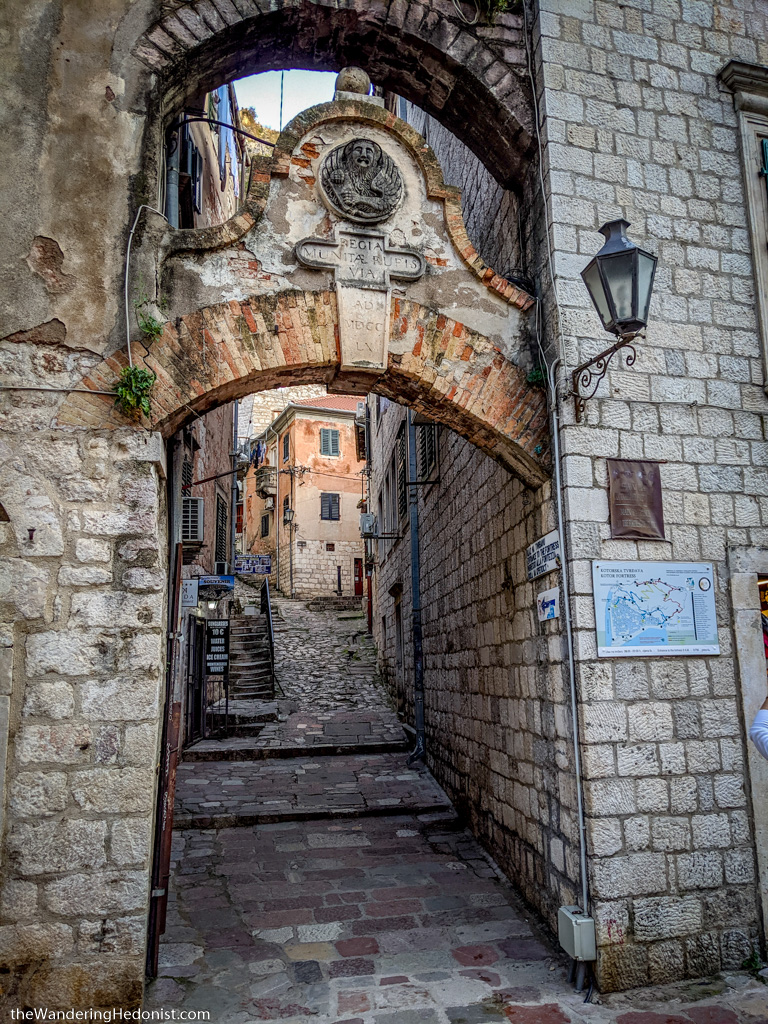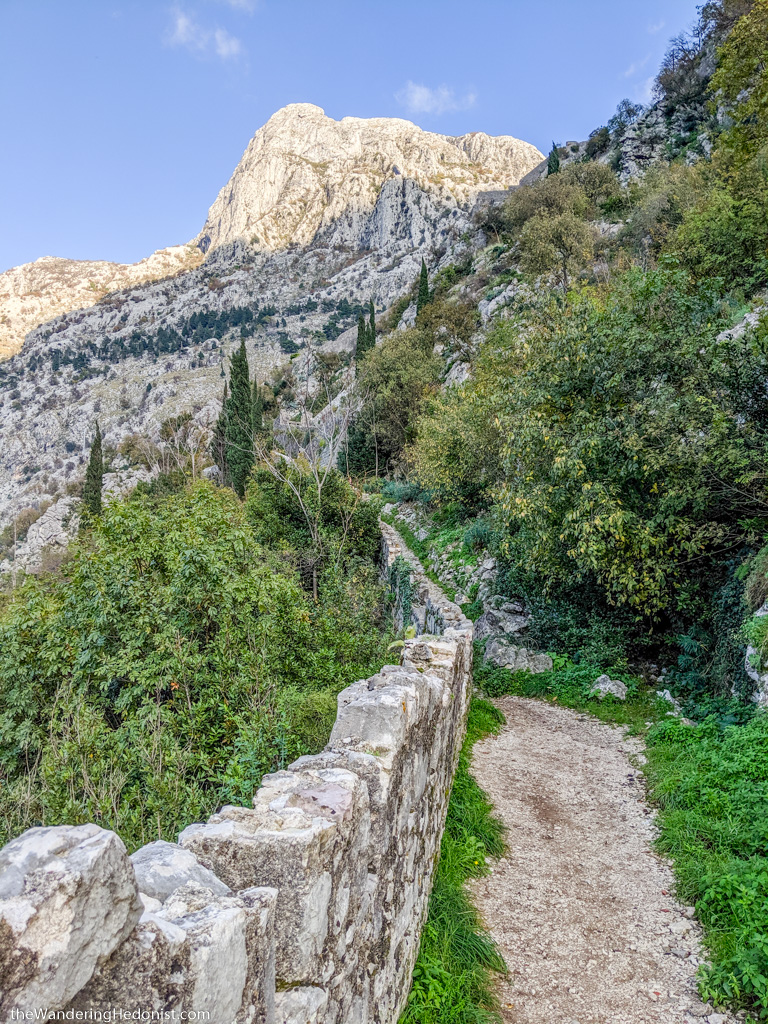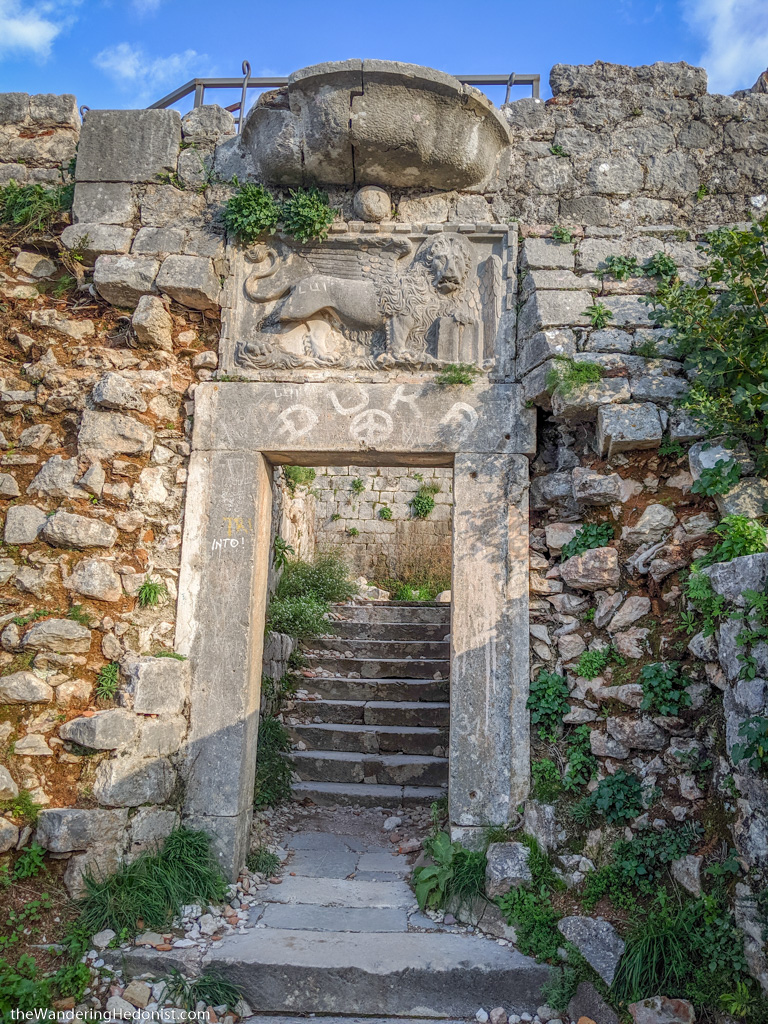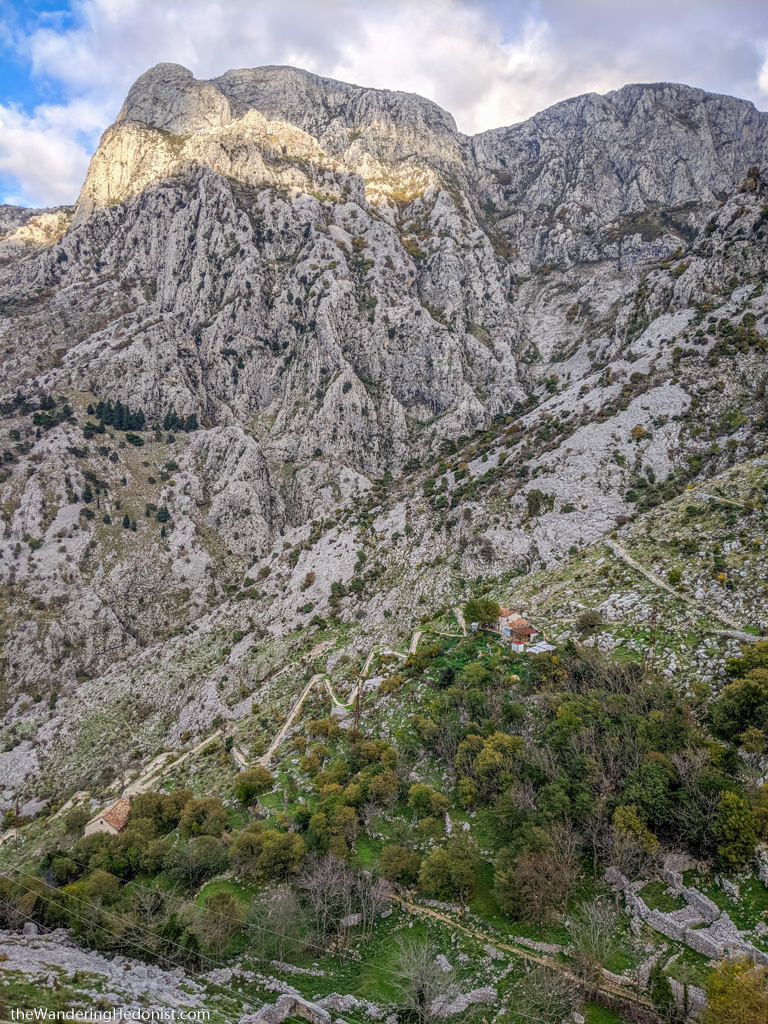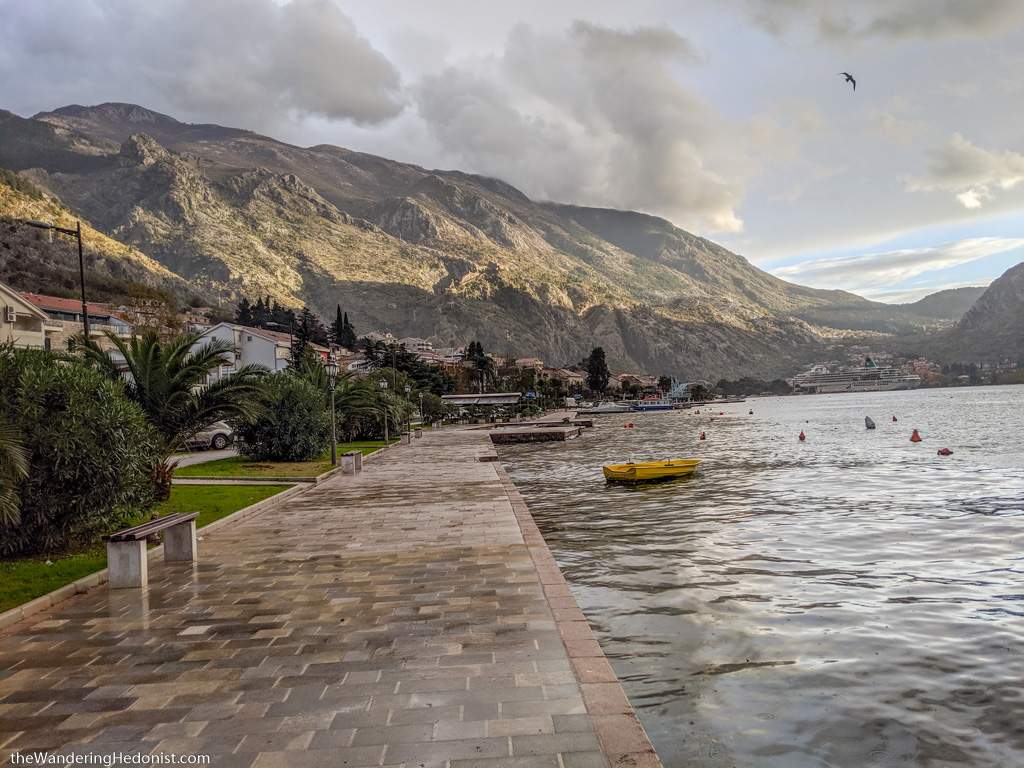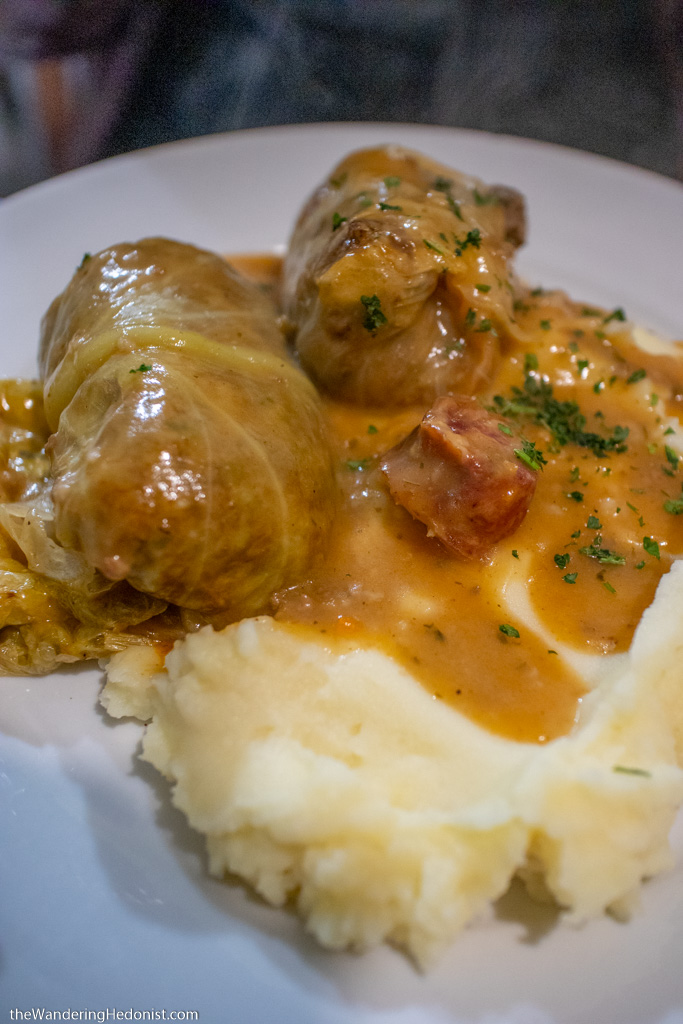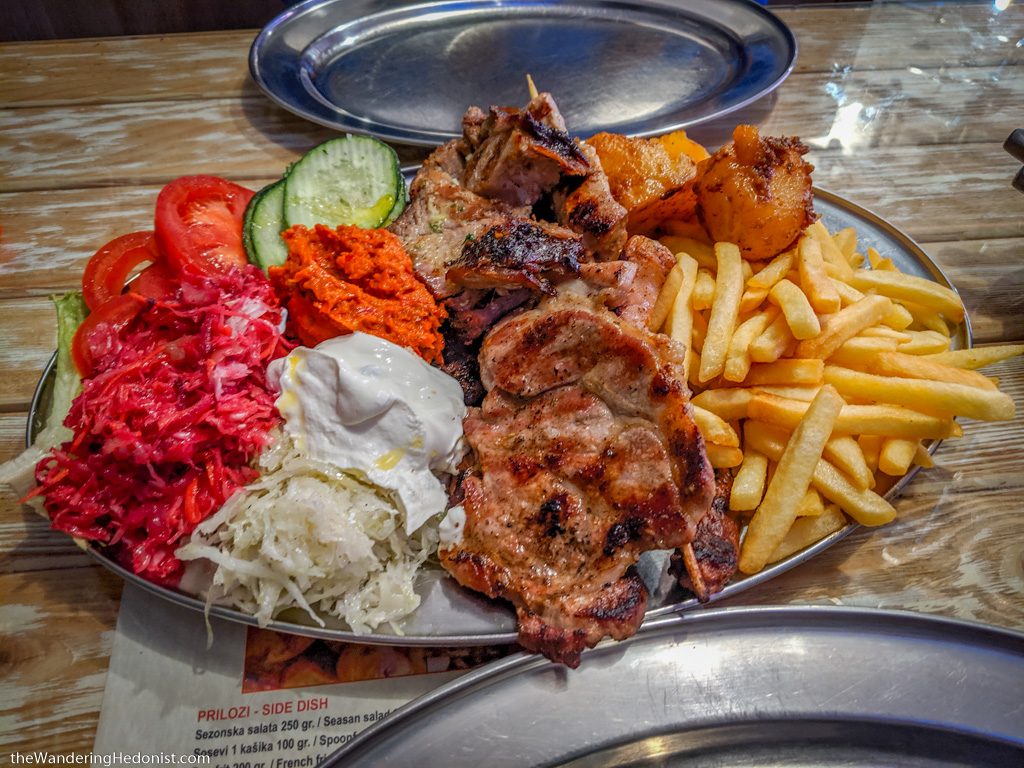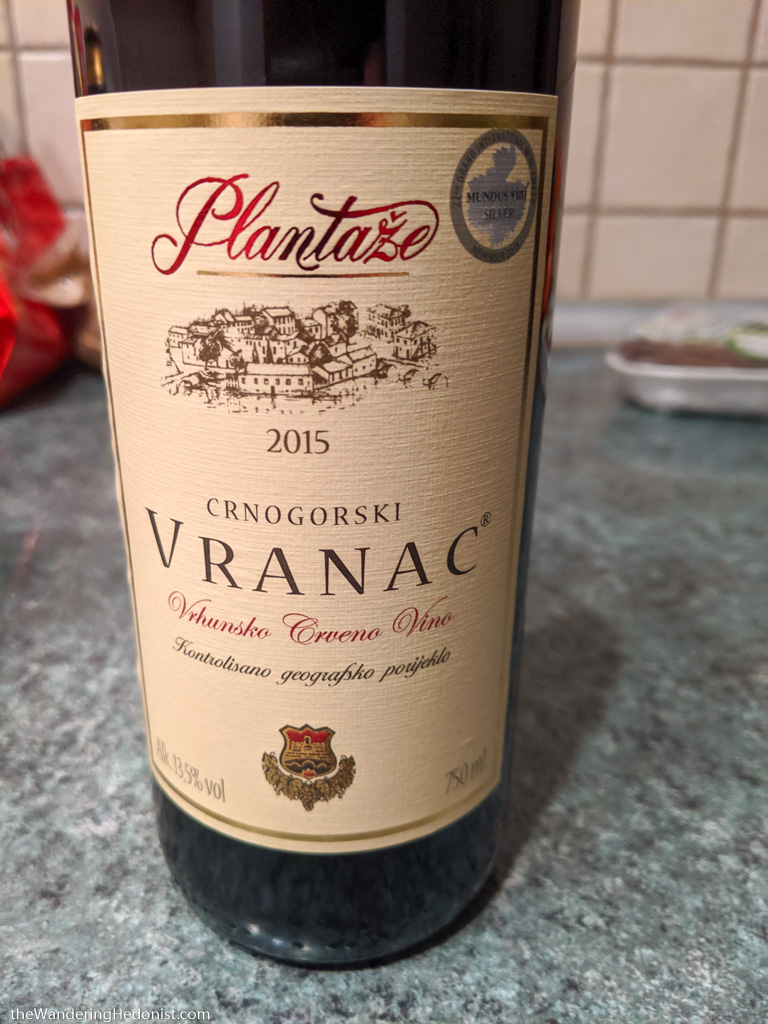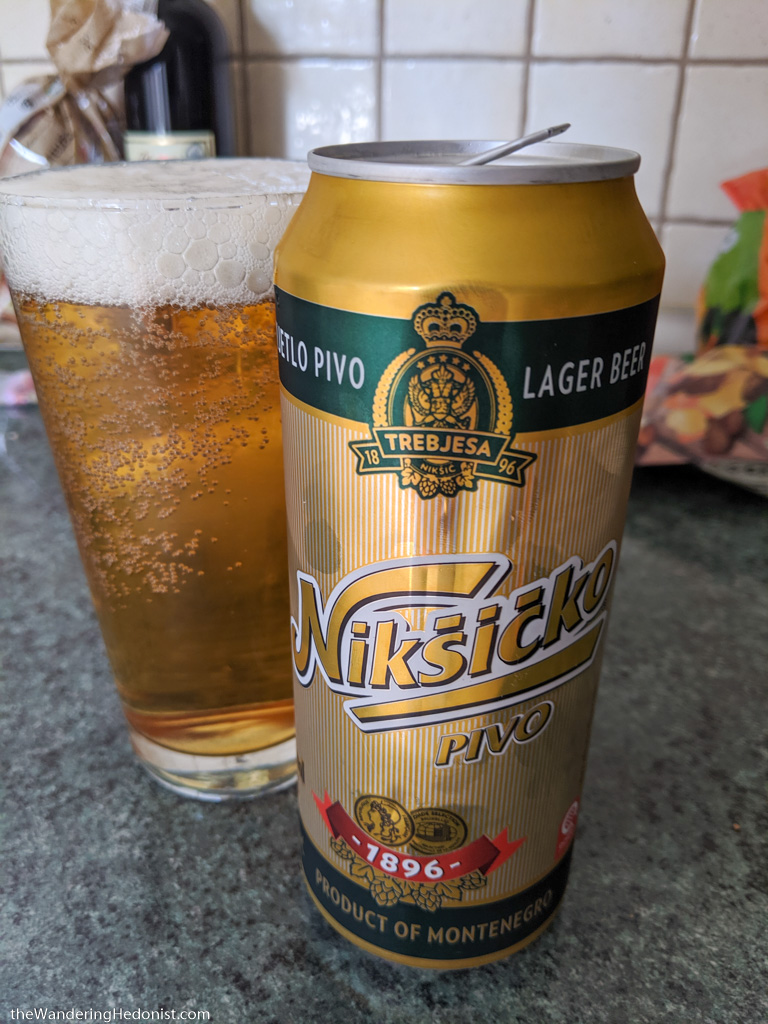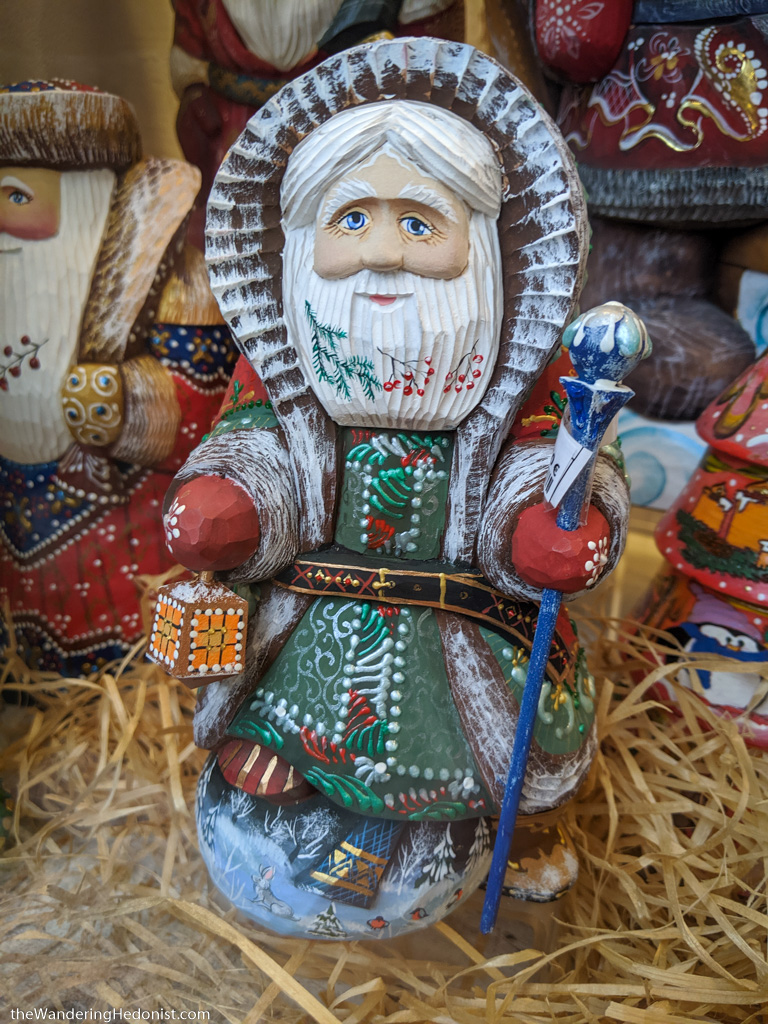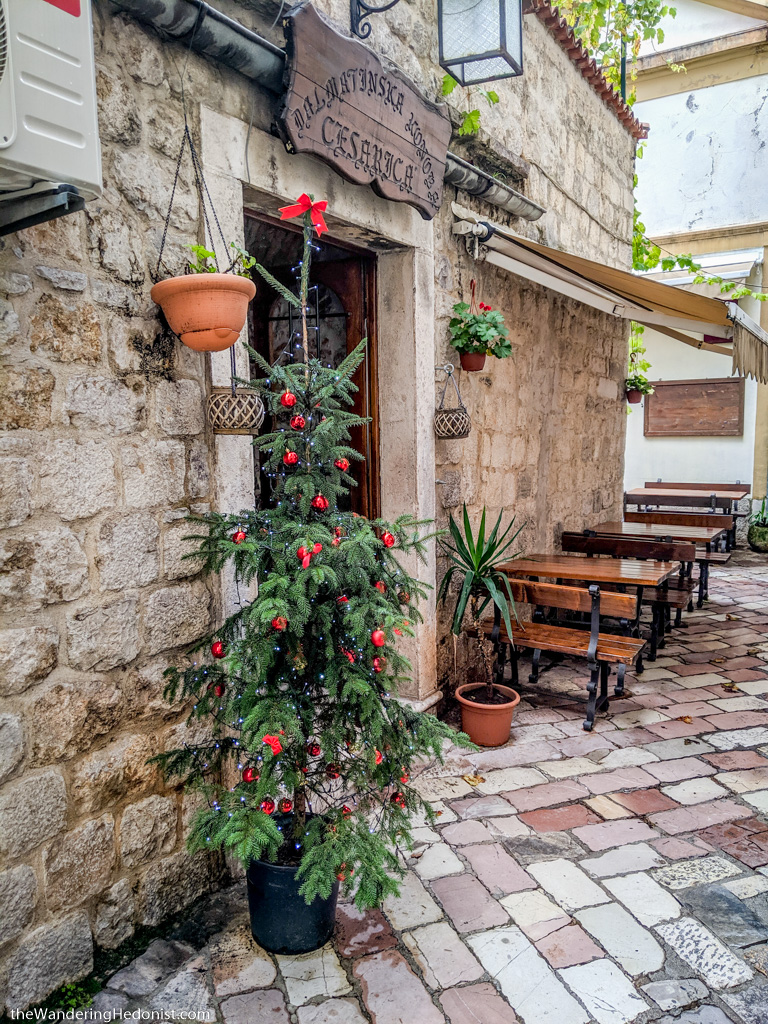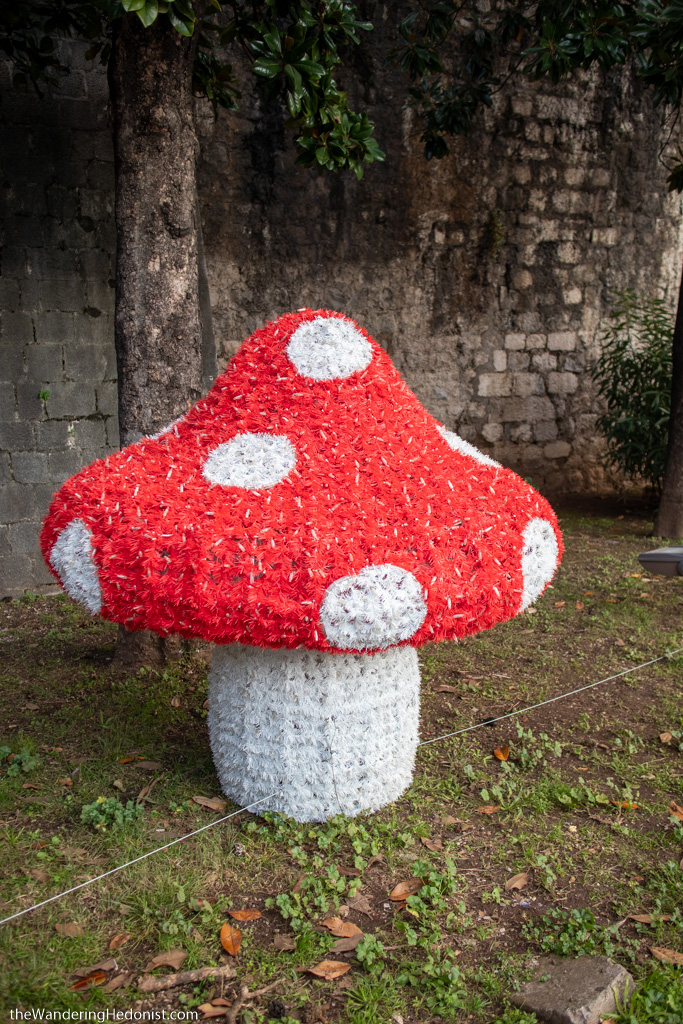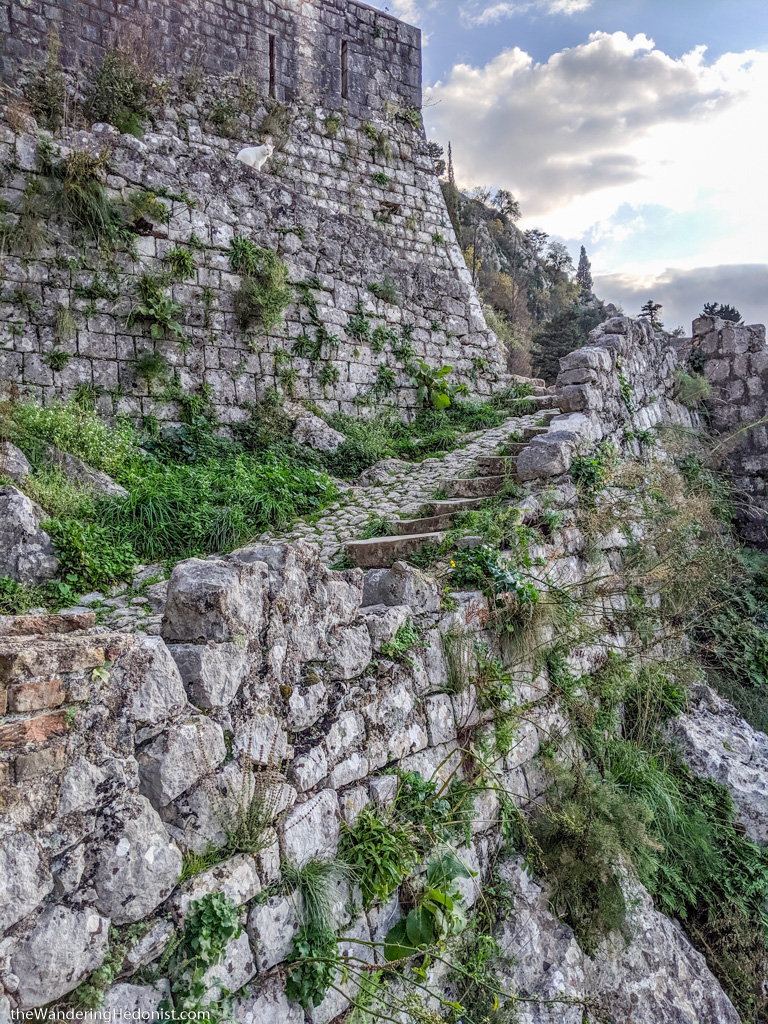Seeing Kotor for the first time takes your breath away. Arriving by the coastal highway you wiggle and wind your way around relentless curving roads tracing the edge of a sprawling inlet at the base of sheer limestone cliffs. The woman beside us discreetly purges into a plastic bag from motion sickness (a fact I choose to keep from Katy until after we’re off the bus). The narrow bay almost comes to a connection point before opening up once again into a long T shaped expanse dotted with small towns, the only road winding along the edge plotting a course for the farthest inlet, and there the ancient walled city of Kotor. The white limestone cliffs loom majestic. This enormous wall of white stone lurching so high above the tiny dots of buildings that it almost seems fantastic. You struggle to take it all in, to internalize it. The contrast of scale.
Kotor was founded over 2 centuries ago, and inhabited who knows how long before that. Like most of the region it has changed hands many times, enjoyed independence, been the jewel of one empire and then the next. The castle high above the town was originally built in 535 by the Romans to defend against the Ostrogoths. At nearly a 1000 feet high, the castle connects to the town walls by a series of winding hillside walls and fortifications that climb up seemingly forever into the mountain heights. I also learned that you can climb up to this castle through the 1355 stairs that wind their way through steep switchbacks and through ruined structures all the way to the top. It’s a hell of a climb and the heights (sometimes with no barrier between you and the cliffside) are dizzying. Definitely one of the highlights of our visit. I chose to climb to the castle while Katy decided on hiking the more difficult Ladder of Kotor, an ancient trail that once was the only way into the valley that parallels the fortress climb and then continues up further into the Lovćen mountains.
Old Town
Like throughout Croatia, the tourist season is over. Our host says that it’s time for us [the townies] to come out and play. The city is theirs again. Occasionally a cruise ship will pull into town and flood the streets with slack jawed tourists following people holding up flags during the daylight hours. But otherwise old town is mostly townies. And unlike other towns in Croatia, it seems like the townies inhabit old town. The pub below our apartment is alive with people late into the night. Either a oonze oonze euro club or exploding with cacophonous chatter and arguments or blasting a live band. It rages into the night. Our AirBnB host can be found there most days and is still up and out at 4am. It’s not like the graveyard atmosphere we’ve found at most old towns. Quite honestly it’s hard to sleep. But the celebration is inspiring and endless.



An art piece where someone made a full set of clothes out leather including socks and lacy underwear to hang on
a line.
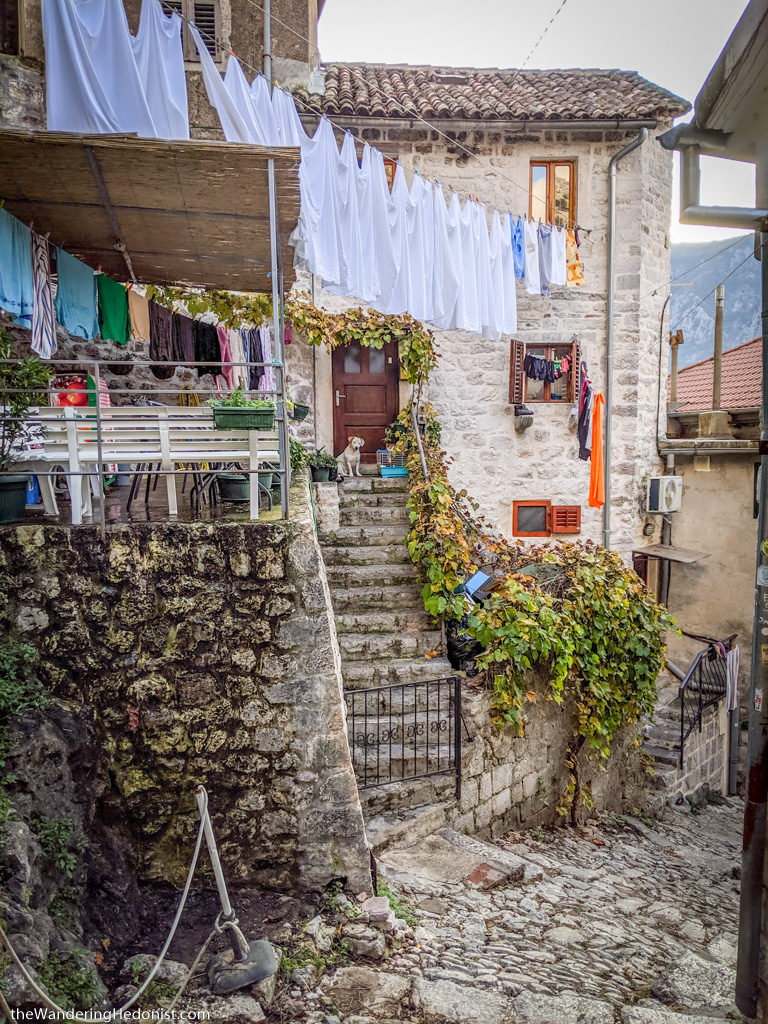

View of the walled city and the walls snaking their way up the mountain (difficult to see it’s so far up)
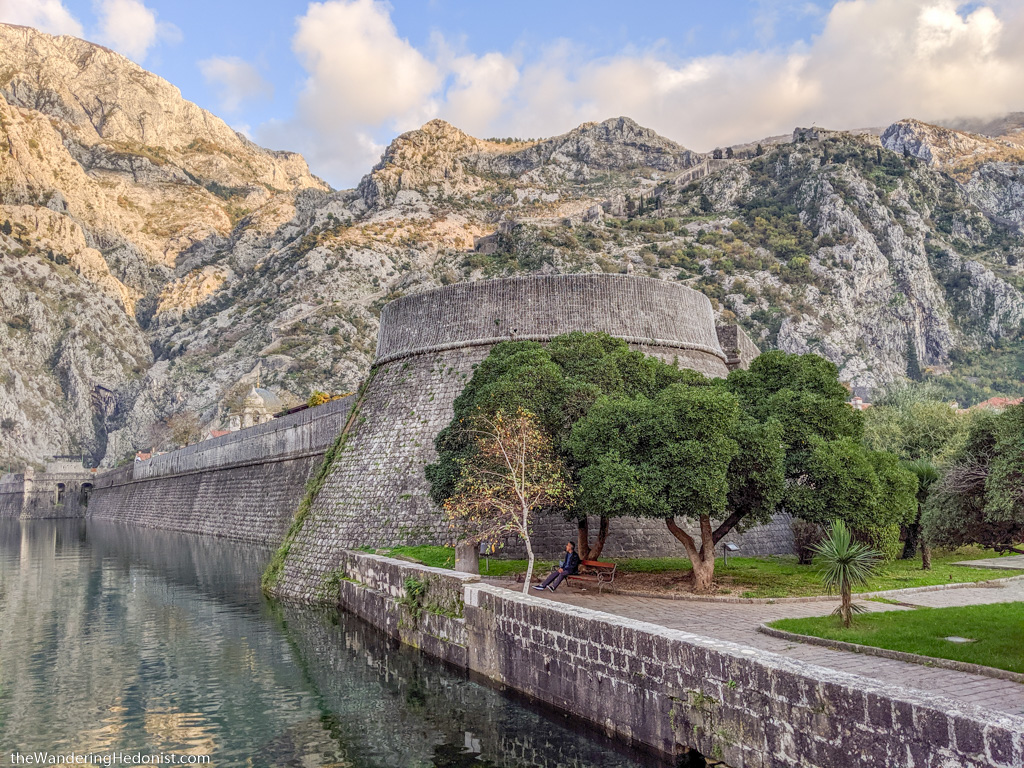
The castle climb
The most obvious thing about Kotor is the elaborate wall and fortification system climbing up into the sheer cliffs over old town. It’s impressive, and the first thing I asked our host about. It’s 1355 steps to climb the almost 1000 feet up into cliffs to get to the ruined castle and I had to go. Running parallel to the fortress is the even more challenging Ladder of Kotor which traditionally was the only overland route to a neighboring village winding about 4 miles one way to a cliffside restaurant or 8 miles roundtrip with over 70 switchbacks. Katy chose the Ladder trail obviously but I chose the castle climb (I’m not there yet), so we hiked in parallel. It was 8 euros to get into the stairs and then a long sweaty climb up steep rough stairs for two hours, winding through ruined fortifications and thin stone pathways that often dropped steeply off the edges with no walls or railings. The views were outstanding and more than one area gave me that deep groin tingling of terrifying heights. It was an awesome experience that I recommend fully.

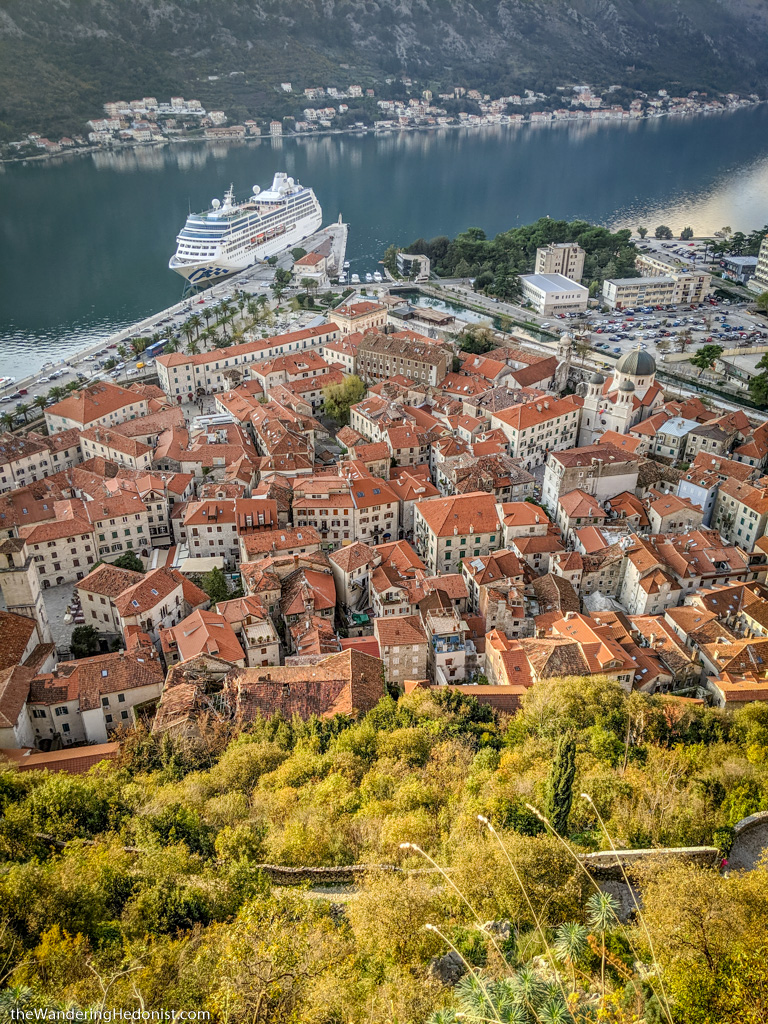
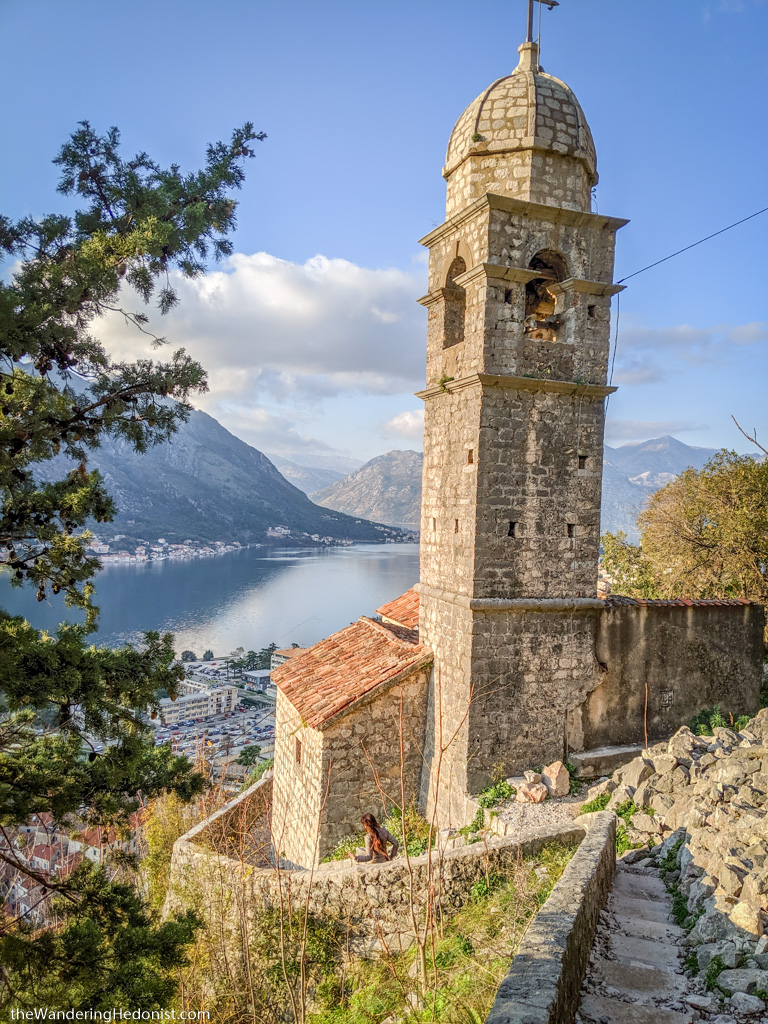

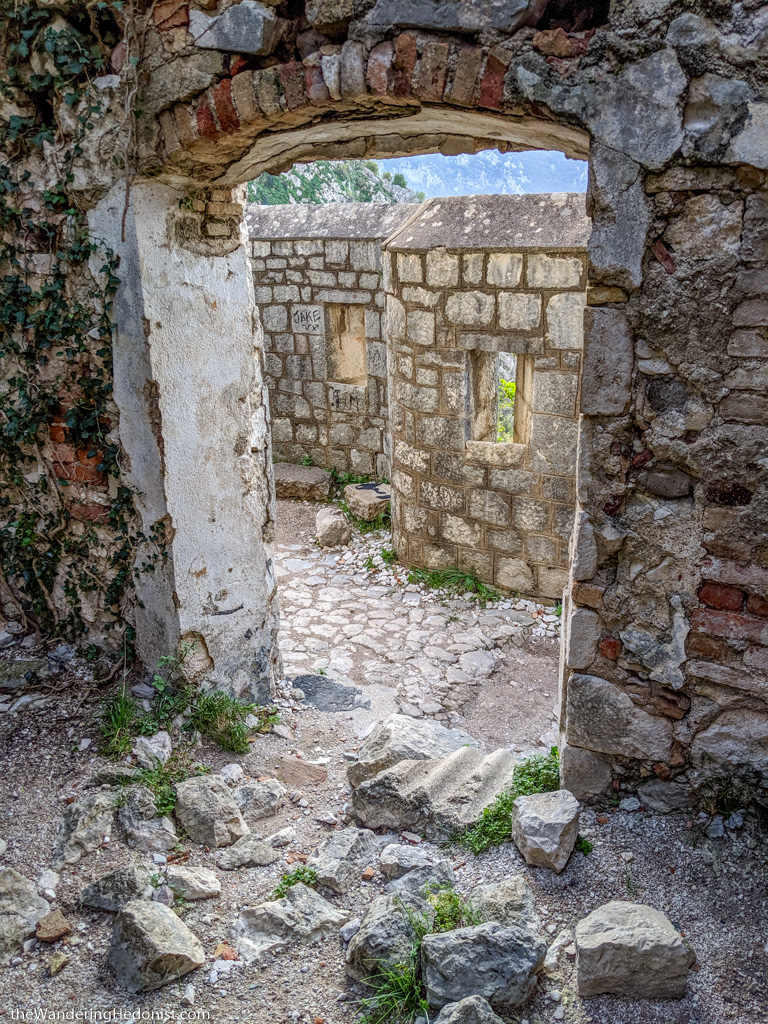
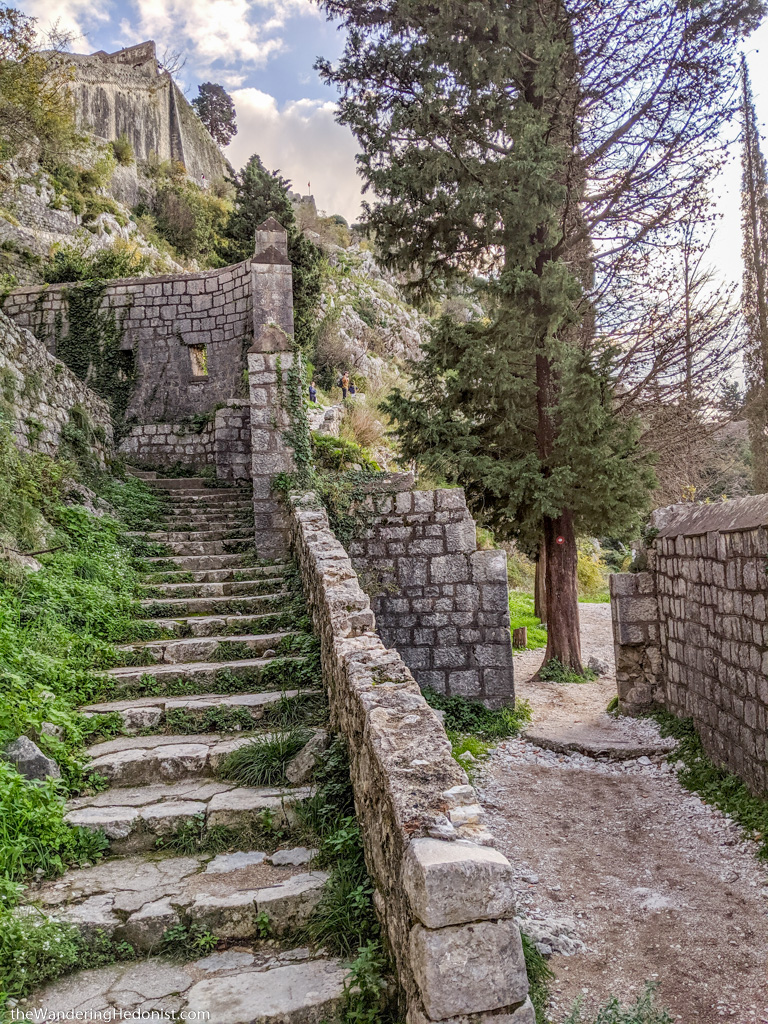
The right path is the correct one. I took the left path and had to climb through a tower window after a dead end. It wasn’t clear.

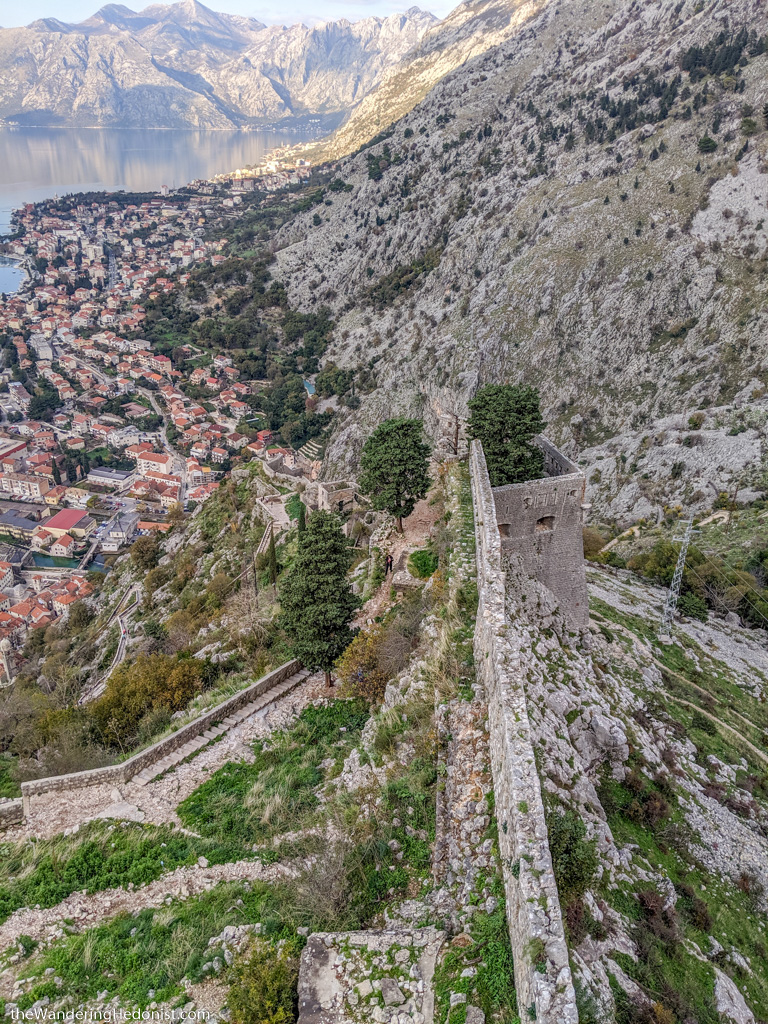

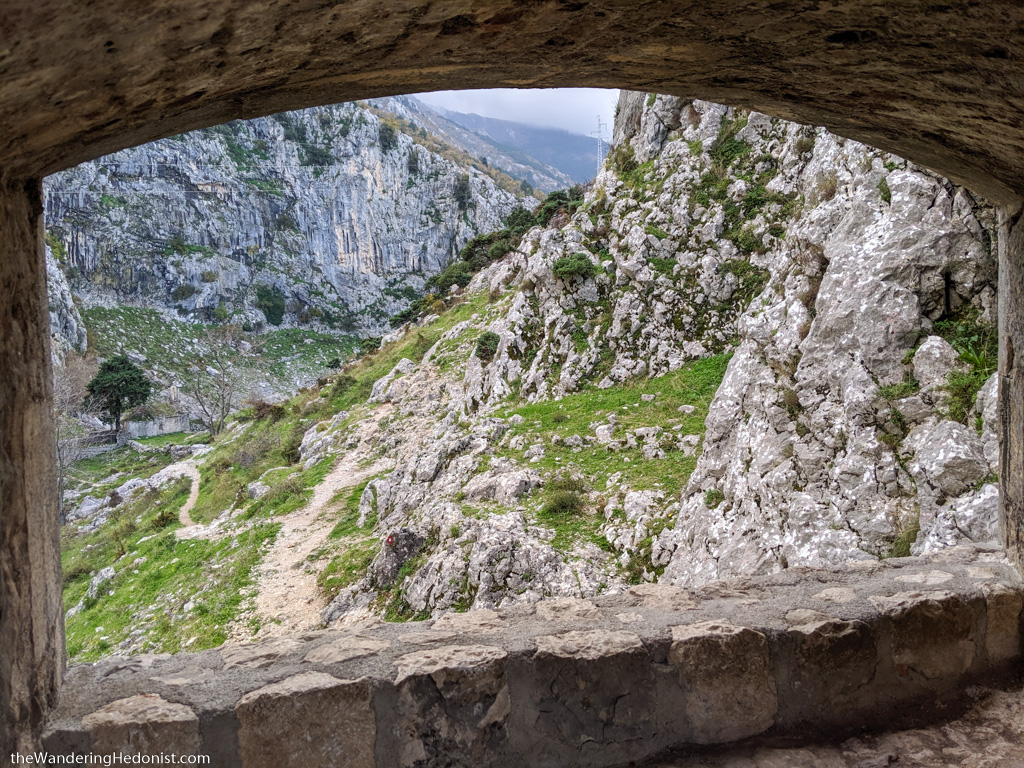
The Ladder of Kotor trailed joined the Castle steps by climbing up through this window. Katy took this path on her way back down the trail.
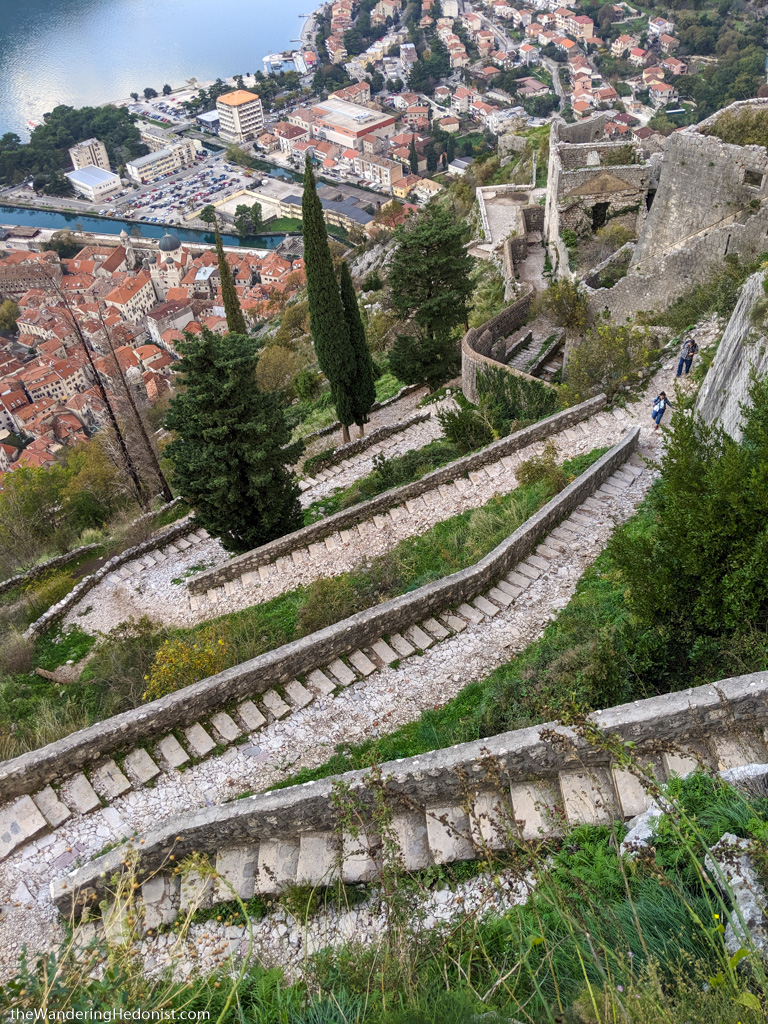

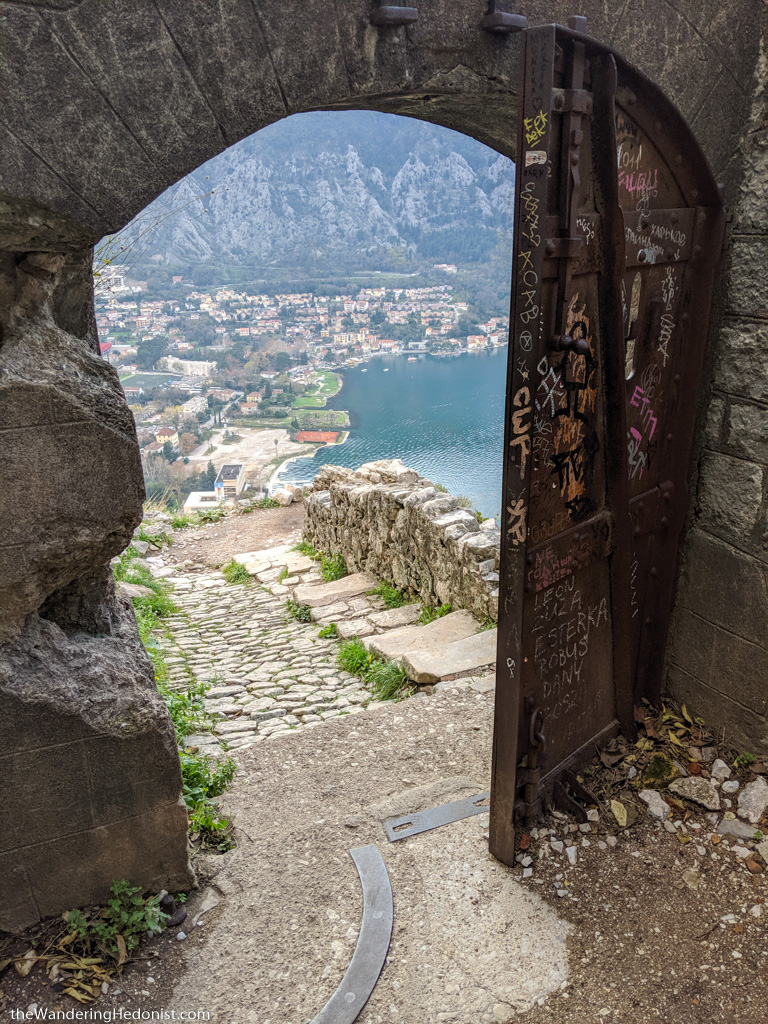
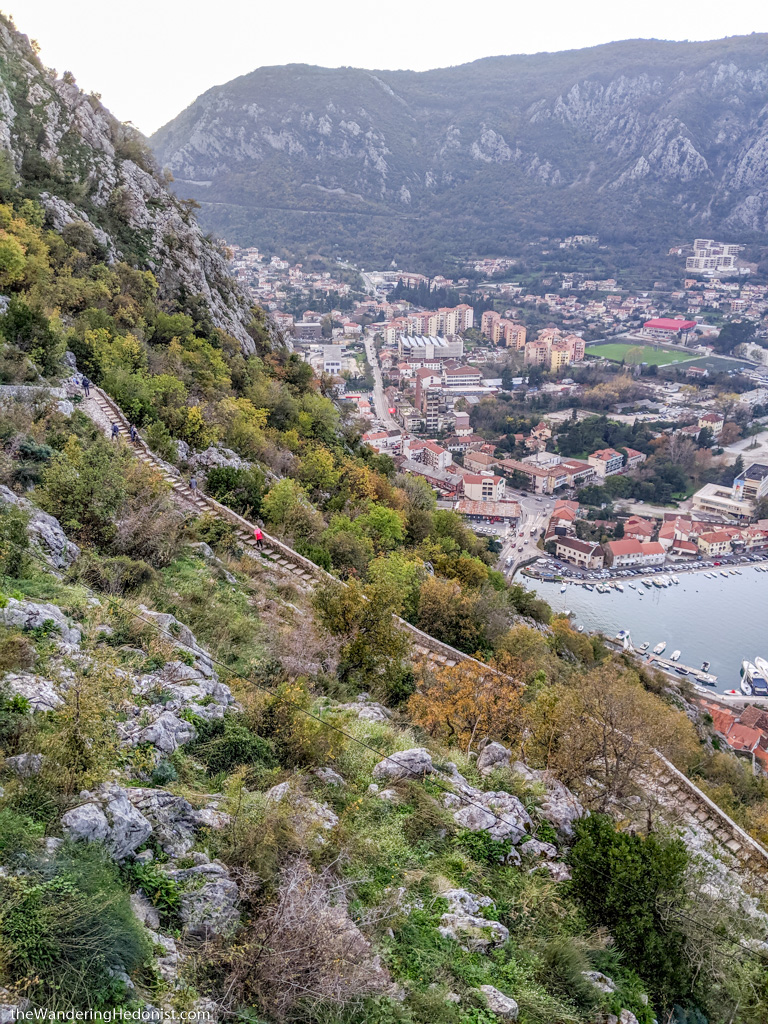
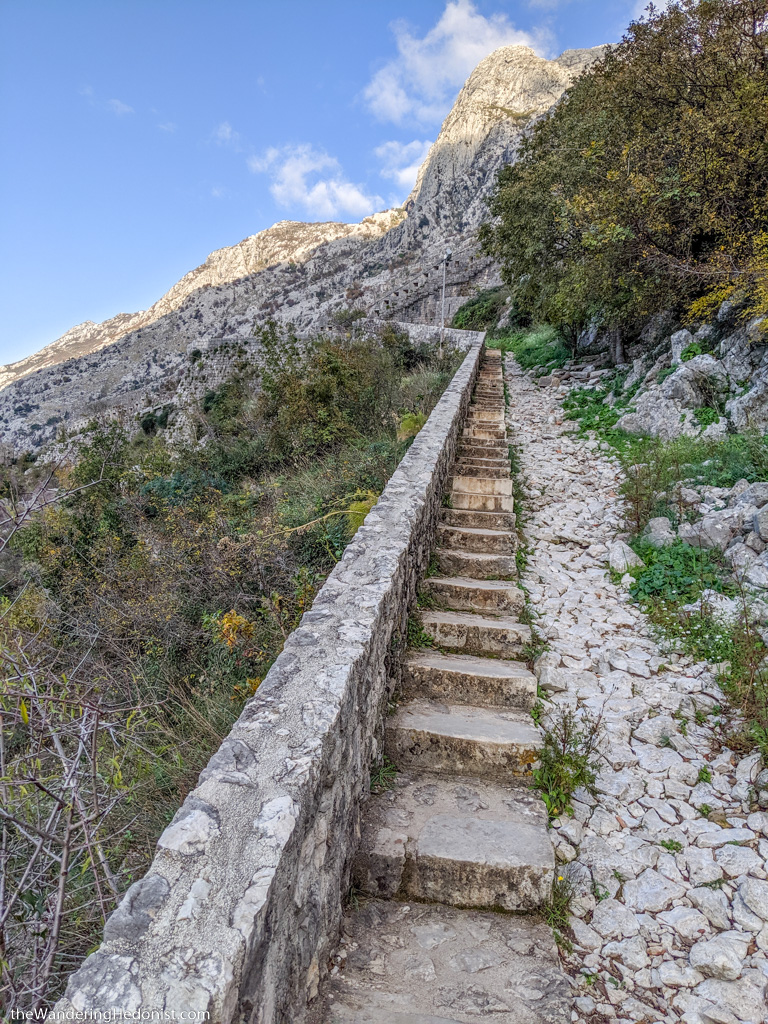
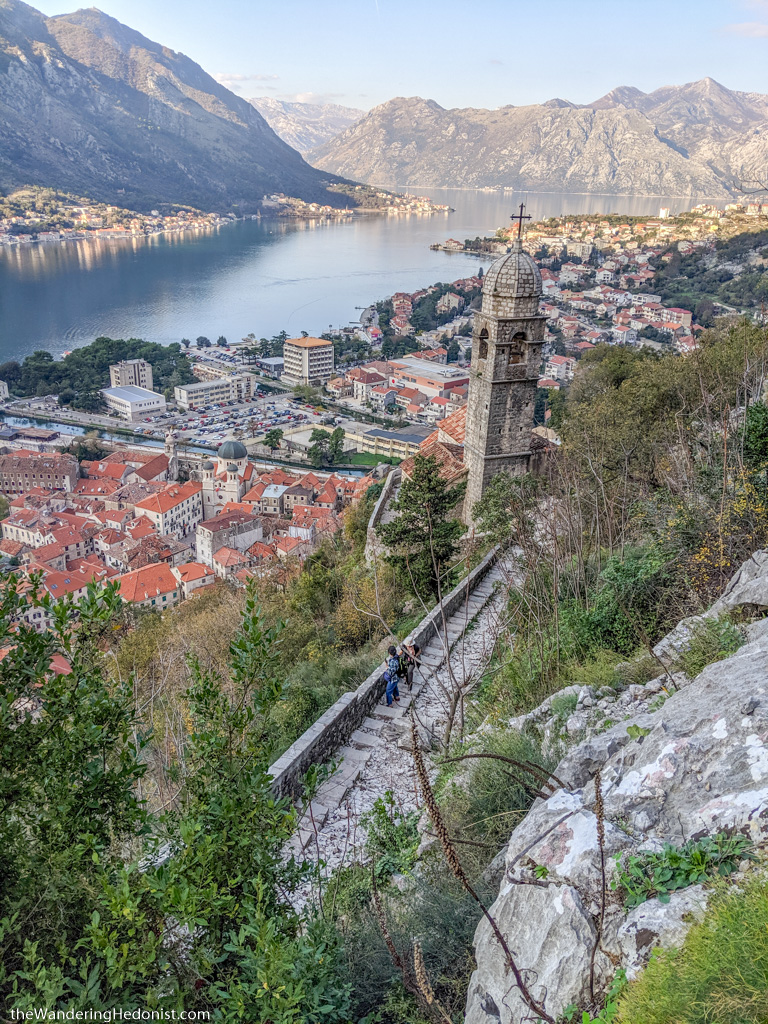

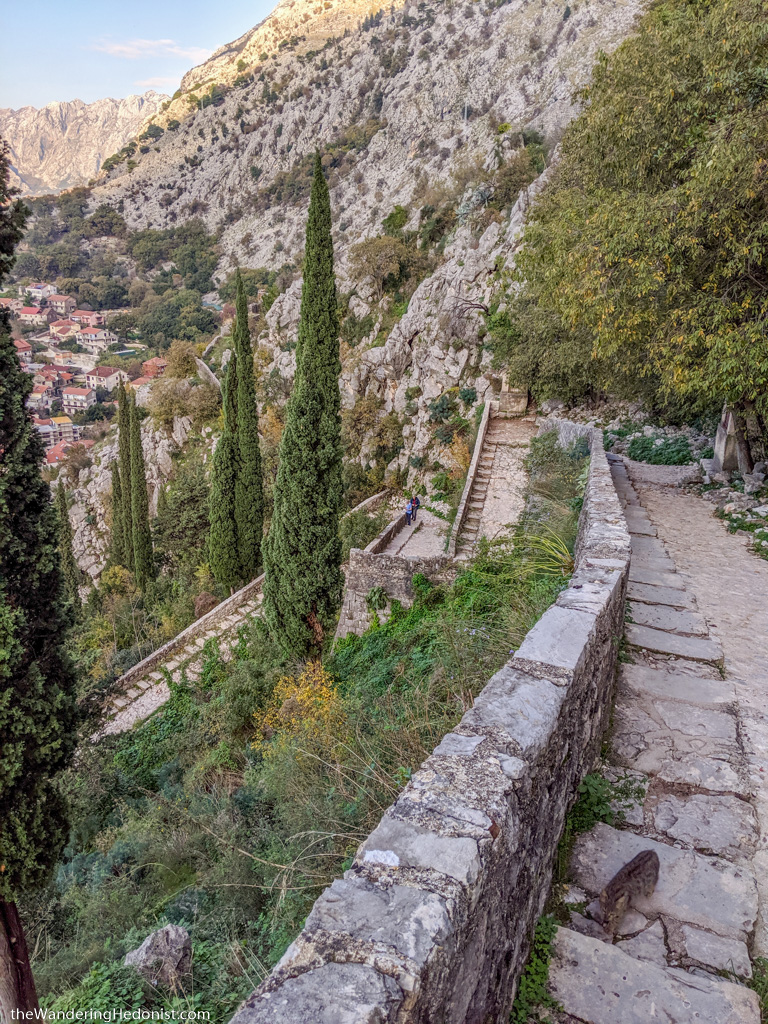
Outside of old town
Outside of old town you find a working class community with signs of struggle. Either from the war or from economic decline you can find several factories in a crumbling abandoned state, graffiti, and worn down houses. The town expands up the valley and along the coast. The coastal buildings seem a bit nicer with restaurants and shops scattered around while the deeper parts of town seemed like your average rust belt US town. But no matter where you find yourself, the enormous cliffs loom overhead in a surrealistic juxtaposition of nature vs. the demure nature of man.
Bastion 3
We ran across a few places in town worth mentioning. As you exit old town via the North Gate you pass over two bodies of water and then run straight into a restaurant. We wondered in by random accident but were very glad we did. The menu is mostly in English but the staff speaks very little English. A good sign in my book. The food is very traditional and a good value. Even though both times that I ate here they got my order wrong, it’s definitely worth trying out. It’s my fault for not knowing Montenegrin. We tried the cabbage rolls, the pasticada, and the boiled pork knuckle, and everything was fabulous. I recommend. We actually decided to have our Thanksgiving dinner here, our first holiday abroad, and had a great time doing so (though don’t expect turkey and stuffing).


BBQ Tanjga
This place was recommended by our host. It’s over in the regular part of town near the bus station on the edge of the bay. In Montenegro we encountered a interesting style of eating that seemed popular. Essentially a butcher type establishment with a deli style display of fresh meats. You can buy the meat raw to go or have the place cook your meat for you and take away or eat there. We chose the 900g mixed meat platter for two which is an obscene amount of meat. It came with vegetables, cabbage, sour cream, ajvar, fries, and other fixins. But waaaaay too much food to eat. Mixed meat plates were popular all over Croatia and this was similar. The main difference was the style of ordering. About half restaurant and half butcher shop. There were a few of these places. The owner was very robust and loved challenging us as Americans to eat all the food and when we couldn’t insisted we didn’t like the food in Montenegro, cheerfully busting our balls. It was all good natured, and there’s no way we could have finished half of it. Honestly I haven’t been able to eat grilled meat since. I was destroyed by this meal. Great value for under 20 euros.
Local hooch
The beer here was a bit different. The main two brands were Nikšićko in a few varieties (good on draught) and Jelen which I preferred bottled. Decent local beer. There was also a local bitter liquor called Gorki List. It’s similar to Pelinkovac in Croatia, but it’s a sage liquor, a bit more herbal and less cologne flavored. I say it’s more drinkable but that’s debatable. The main red wine here was Vranac and the white wine was Krstac. Liquor was cheap. I could get a 2 liter bottle of Nikšićko for 1.50 euros and 1.5L of Jelen for the same. Wine was around 5 euros. Actually all of the food and liquor in Montenegro was cheap. Much cheaper than Croatia.
Christmas
Christmas was just setting up here when we arrived in late November. It was fun to get a bit of holiday flavor.
The cats of Kotor
Kotor shares a special bond with cats and it’s evident throughout town. Most towns we’ve visited had a flourishing population of wild cats but none so prolific as Kotor. It’s said that the town had a devastating bout with the Plague and the cats controlled the rat population and saved the city. Today cats are everywhere, throughout town and all through the castle steps and fortresses. There’s a cat museum and cat shops.
